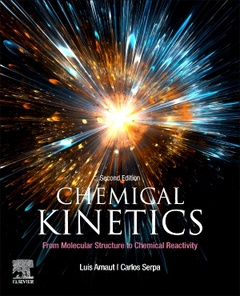Description
Chemical Kinetics (2nd Ed.)
From Molecular Structure to Chemical Reactivity
Language: English
Subject for Chemical Kinetics:
Keywords
?ADME; ADME-Tox; Absolute rate calculation; Acid catalysis; Acidity function; Activation energy; Active site; Adatom; Adiabatic reactions; Arrhenius intermediate; Base catalysis; Bell; Brönsted coefficient; Brönsted equation; CO oxidation; Catalysts; Chain branching; Chain initiation; Chain propagation; Chain termination; Chemical reaction; Chemisorption; Chymotrypsin; Classical trajectories; Clinical toxicity; Cofactor; Cold flame; Collision; Collision theory; Combustion; Competitive adsorption; Competitive inhibitor; Concentration variation; Conventional kinetic methods; Debye–Hückel theory; Degrees of freedom; Desolation; Differential equation; Diffusion coefficient; Diffusion control; Drug design; Drug development programs; EC50; Eigen ion; Electron transfer; Electrophilicity; Electrophilicity index; Electrostriction; Evans; Exponential term; Fick's first law; First coordination shell; Flow methods; Franck–Rabinowitch effect; Free-energy relationships; General acid–base catalysis; Goldfinger–Letort–Niclause rules; Halogen–hydrogen reactions; Hammett relationship; Hammond postulate; Hard-sphere model; Harpooning mechanism; Hydrogen bonding; Hydrostatic pressure; Inner-sphere mechanism; Internal pressure; Intersecting-state model; Ionic strength; Isomerisation; Kinetic isotope effect; Kinetic law; Landau-Zener crossing; Langevin cross section; Langmuir isotherm; Langmuir–Hinshelwood mechanism; Leaving group; Lindemann–Christiansen mechanism; Line-of-centres model; Lipoxygenase-1; Marcus cross reaction; Marcus equation; Mayr; Menshutkin reaction; Michaelis constant; Michaelis–Menten equation; Molecular bonds reorganisation; Molecular dynamics; Monotonic behaviour; Nuclear coordinates; Nucleophile; Nucleophilic substitution; Nucleophilicity; One-compartment model; Outer-sphere mechanism; Oxygen quenching; PH dependence; Partition functions; Patz equation; Pharmaceutical compounds; Physisorption
694 p. · 19x23.4 cm · Paperback
Description
/li>Contents
/li>Biography
/li>Comment
/li>
Chemical Kinetics: From Molecular Structure to Chemical Reactivity, Second Edition, explains how molecular structures change with time. It offers a comprehensive and coherent coverage of the rates of chemical transformations.
The book is written for both undergraduate chemistry students, and for the specialist. The newcomer will find the fundamental concepts, the simple experiments, and the underlying theories. For the seasoned specialist, it presents sophisticated experimental and theoretical methods, offering a panorama of time-dependent molecular phenomena connected by a new rationale. The gap between the two is bridged by a logical path that leads the reader from a phenomenological approach of molecular changes, to the formalism of chemical reaction rates, and then to state-of-the-art calculations of rate constants of the most prevalent reactions: atom transfers, catalysis, proton transfers, substitution reactions, energy transfers and electron transfers. In the process, the reader is presented with the details of collision and transition state theories. The coverage includes unimolecular reactions in the gas phase, reactions in solution and reactions on surfaces.
2. Reaction rate laws
3. Experimental methods
4. Rate constants and reaction orders
5. Collisions and molecular dynamics
6. Reactivity in thermalized systems
7. Structure-Reactivity Relationships
8. Unimolecular Reactions
9. Reaction in solution
10. Reactions in surfaces
11. Nucleophilic substitution reactions
12. Chain reactions
13. Acid-base catalysis and proton-transfer reactions
14. Enzyme catalysis
15. Transitions between electronic states
16. Electron transfers
17. Fractals, chaos and oscillatory reactions
18. Pharmacokinetics
- All first edition chapters were revised and most were extended
- Features two new chapters, one on Pharmacokinetics and the other on Oscillatory Reactions and Chaos
- Includes practical examples, detailed theoretical calculations, and cross-relations between reactions throughout the text to underscore key concepts
- The rigor of mathematical description of phenomena is combined with simple and profusely-illustrated concepts
- Provides a state-of-the-art presentation on the kinetics of reactions implicated in the most active research fields




